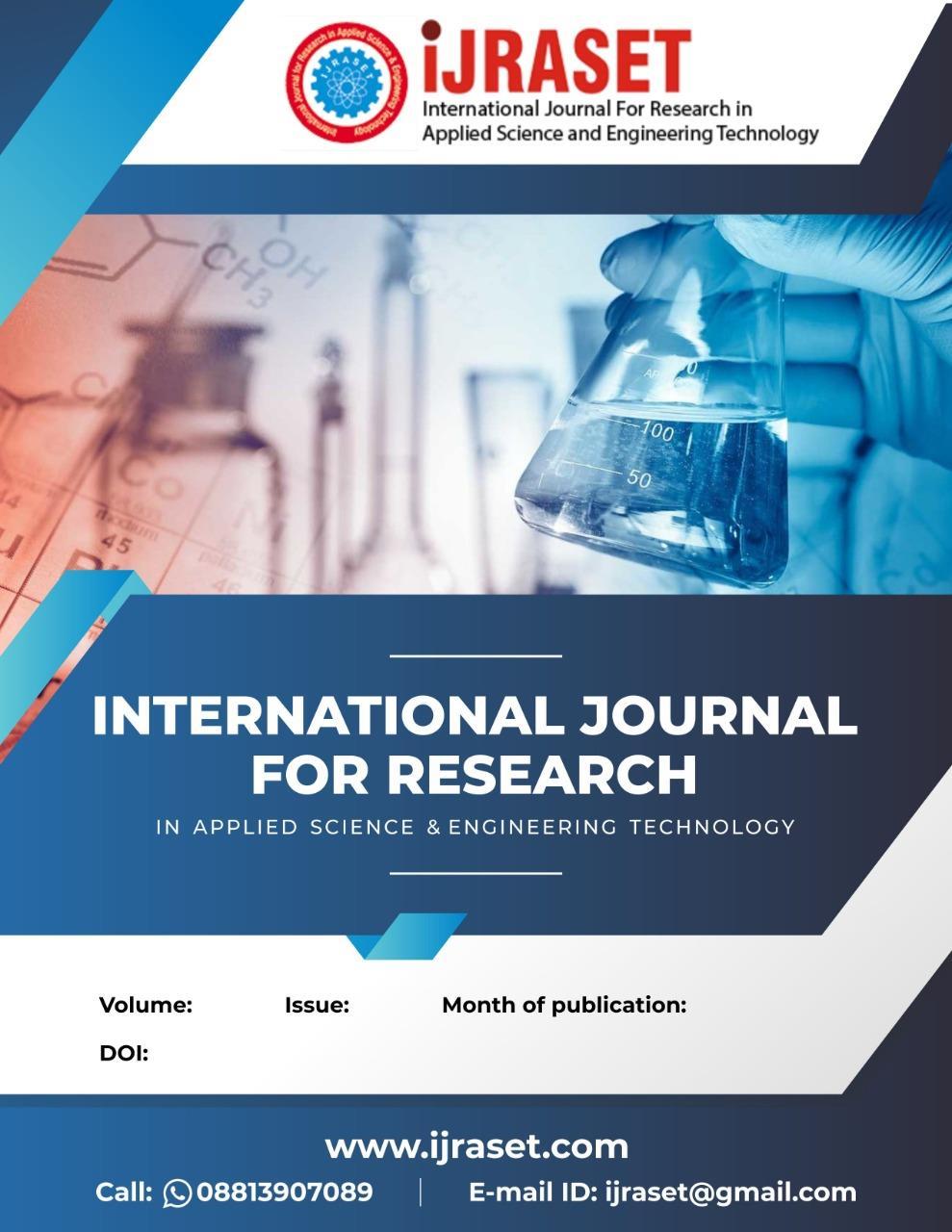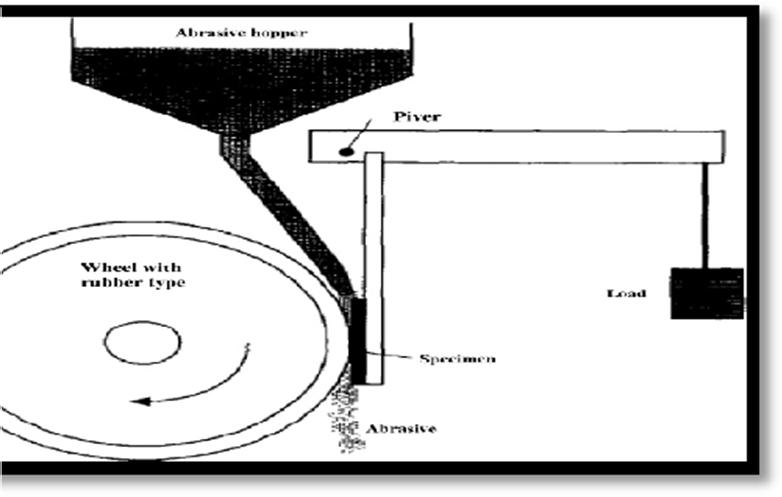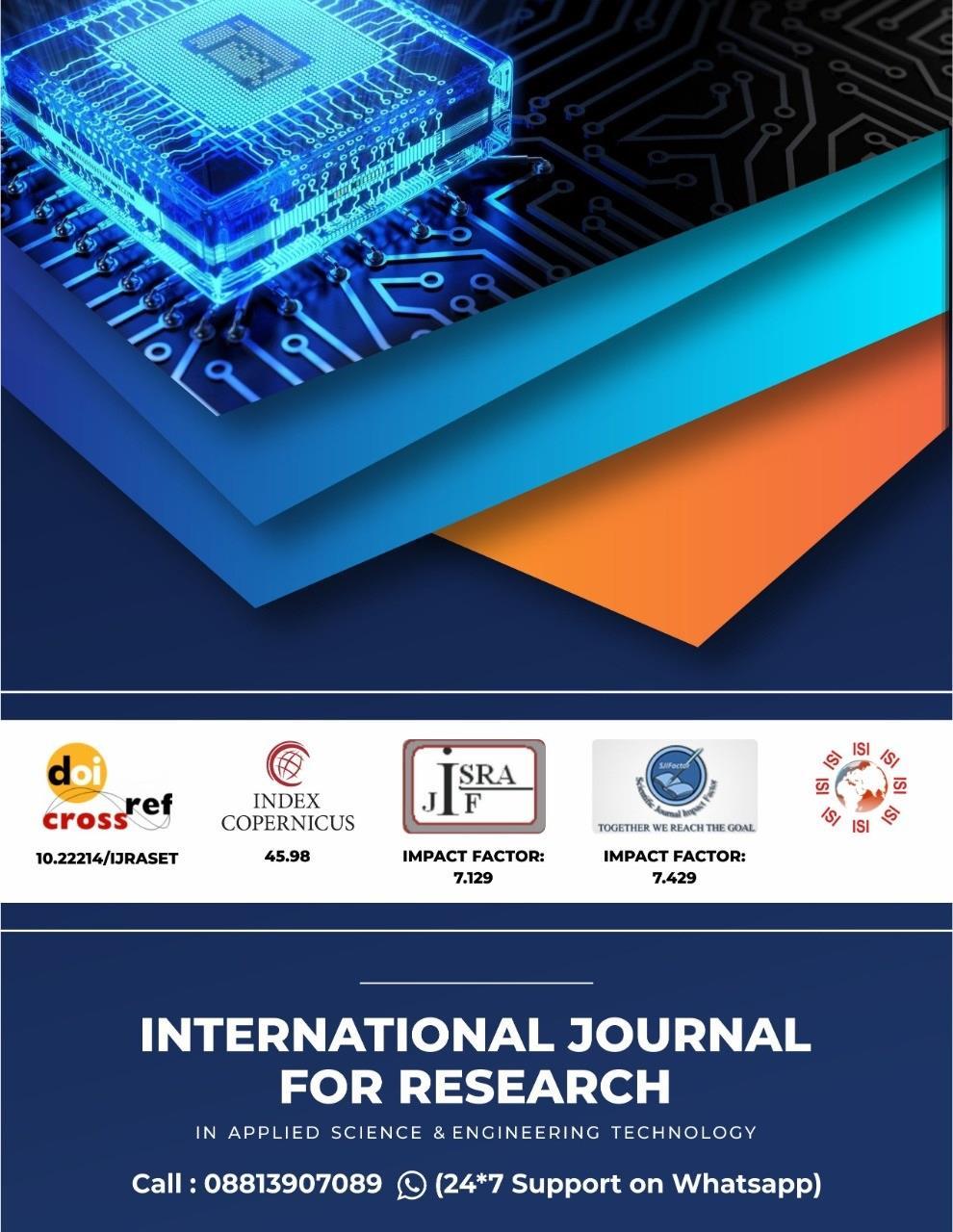
ISSN: 2321
IC Value:
SJ Impact Factor:
10 Issue VIII Aug 2022 Available at www.ijraset.com


ISSN: 2321
IC Value:
SJ Impact Factor:
10 Issue VIII Aug 2022 Available at www.ijraset.com
Pankaj Dhiman1, Dushyant Kaistha2 , Shabnam Dhiman3 ,Swati Kaistha4
1Department of Mechanical Engineering, himanchal institute of engineering and techonology shahpur kangra (176052), India 2, 3, 4Department of computer Engineering, himanchal institute of engineering and techonology shahpur kangra (176052), India

Abstract: Wear is the degradation of material under plethora of service conditions and is considered as one of the major issue of the material used in engineering. So far, various types of wear have been recognized such as erosive wear, surface fatigue, fretting wear, adhesive wear, abrasive wear and sliding wear. Wear by abrasion accounts for more than 50% of the wear failures occurring in industries. Hard abrasive particles penetrate the components and cause damage in the form of material loss. The components of machines working undersevere conditions the soil engaging part of the earth-moving machinery, and various agricultural implements experience sever wear. The wear in agricultural equipments and tillage is the main problem. For combating with wear problem various methods have also been developed such as hardfacing, cryogenic treatment, coating and heat treatment of components, which are chosen on the basis of various conditions under which the component has to perform the desired function. Hardfacing and heat treatment is commonly used to resistthis failure, also considered as most appropriate and economically sound process for improving the life of tillage tool at farming level. In the present paper author as made the effort to review various types of wear and remedial measures.
Keywords: Wear, Hardfacing, MMAW, Wear type, Hardfacing electrode.
Wear is a phenomenon of material removal from one or both the solid surfaces in solid state contact, due to sliding and rolling motion with each other. Every machines/machine components faces wear problems in industry today. It is a severe problem in the excavation, earth moving and agriculture equipments etc. The high wear rate of ground engaging tools make a cause of huge loss of material, recurring labour, downtime and replacement costs of worn out parts. Due to loss of material lifespan of the tool will also affect (Bayhan, 2006).The process of wear is not only accountable for removal of material but also leads to early failure of engineering components. Tillage tool wear in agricultural machinery used for soil processing is a consequence of metal interaction with natural hard and sharp soil particles, which are continuously supplied, as the tool breaks the soil and has to overcome frictional forces (Natsis et al, 2008).

Following are four main types of wear:
1) Abrasive Wear: In engineering industries, abrasive wear is probably the most significant cause of mechanical damage of equipment components coming in contact with abrasive bodies. Generally it is identified as three body abrasion. In engineering industry, it has been expected that about 50% of all wear problems are due to abrasion (Sapate et al, 2007). Generally abrasive wear occurs when hard abrasive particles go through the components and make a cause of material loss. These are some components of machines working under severeconditions, like a fluid pump handling slurry, the soil engaging tools of the earthmover machinery, and various agricultural equipments are subjected to abrasive wear (Kumar et al, 1999). The cost of abrasive wear losses is high and has been estimated as ranging from 1 to 4% in the gross national product of an industrialized nation. 80 to 90 percent of machine partsin the industry are known to fail with the damage of surface wear (Ming Lin et al. 2010). Abrasive wear processes have typically been divided into two regimes: high stress and low stress abrasive wear (Hawk et al. 1999). In agriculture equipments, abrasive wear of soil engaging components is a serious problem because of huge loss of material, recurring labour, downtime and replacement costs of worn out parts (Par and ER U, 2005). Globally, the majority of soil tillage tool is the moldboard plough and the ploughshare, which is subjected to higher wear fraction in the soil tillage application, is one of the basis soil engaging parts of the moldboard plough. Abrasive wear critically affects the production planning, the tillage quality and the energy consumption for the tillage process each time when the action is performed, so the determination of the wear loss of tillage tools is essential [Yazici, 2011]. In a research conducted in Turkey, it is found that
Factor
Applied Science & Engineering Technology (IJRASET)

ISSN: 2321 9653; IC Value: 45.98; SJ Impact Factor: 7.538 Volume 10 Issue VIII Aug 2022 Available at www.ijraset.com
there is on an average 2.7 6.3 g km 1 (90 210g ha 1) of wear in a ploughshare, 2.5 5 g km 1 (60 120 g ha 1) wear in cultivator sweeps and 0.15 0.32 g km 1 (30 70 g ha 1) wear in harrow tines. Chisel ploughshare wear has been found as 6.94 11.94 g km 1 (23 40 g ha 1). The field area of cultivated land in Turkey is approximate 18,500,000 ha. The total amount of wear on the share of these tools is about 5365 tons since the above mentioned area is cultivated by a plough, a cultivator and a harrow at least once. This totals up to nearly4.4 million $ of loss per year (Bayhan 2005).
2) Adhesive Wear: Is considered as the repositioning of material from one surface to another as aresult of localized bonding between contacting surfaces (Deuis et al. 1996). This phenomenonof degradation of surface can generally be seen in many components. For instance, in the fast breeder reactors, many important components inside the reactor core are subjected to sliding wear, and due to poor tribological properties a couple of components are observed to have low sliding wear resistance, unstable friction qualities, subsurface damage and formation of strong adhesion due to surface sliding over the another surface (Li and Wang, 2008).

3) Fretting Wear: Is one of commonly observed failure mode in bearing assemblies. It is due to small amplitude oscillatory motion between the contacting surfaces of bearing races, rolling elements and shaft/housing assemblies. The loss of fit due to fretting wear leads to increased noise and vibration in bearing assemblies. A large number of parameters such as mating material combination, slip amplitude, normal load, frequency, surface treatment, surfacecondition and environment were found to influence the fretting wear characteristics of engineeringmaterials (Ramesh and Gnanamoorthy, 2006).
4) Sliding Wear: Is a two body wear in which the degradation of surfaces is a result of a relative motion between two surfaces and the initial mechanical contact between the surfaces. The differentiation between sliding and abrasive wear is not sharp. Both are part of wear spectrumranging from pure cutting to ploughing type deformation without formation of cutting chips (Rigney et al. 1988).
5) Corrosive Wear: Occurs as a result of chemical reaction on a wearing surface. The most common form of corrosion is due to a reaction between the metal and oxygen (oxidation). Corrosion products, usually oxide, have shear strengths different from those of the wearing surface metals from which they are formed. The oxides tend to flake away, resulting in the pitting of wearing surfaces. Generally corrosive wear occurs in situations in which theenvironment surrounding a sliding surface is corrosive in nature (Bateni et al, 2006).
Wear cannot be eliminated entirely, but it can be reduced. To overcome the problem of wear several attempts have been made in various aspects such as characterization of tillage tooland improvements of its design, the modification in equipment design and change of service parameters. The most frequently used strategies adopted to conflict wear problem in engineering industries are based on use of alternative and more wear resistant materials, by modifying the surface properties by heat treatment and use of appropriate wear resistant coatings (Sapate et al, 2007). There is a diversity of techniques for modifying the surface properties of the substrates (Xing et al, 2006). Chromium rich electrodes are broadly used due to low cost and availability; however, more expensive tungsten or vanadium rich alloys offer better performance due to a good combination of hardness and toughness. Complex carbide electrodes are also used; particularly when abrasive wear is accompanied by other wear mechanisms (Buchely et al, 2005). The process of wear analysis is simplified byfrequent technique known as Computer models (Stachowiak et al, 2008). Wear protection methods have the vital assumption that higher the hardness, higher will the resistance against the abrasion wear, but the influence of material is very much complex as only hardness is not enough (Horvat et al. 2008). To achieve these preferred properties, the surface treatment has been suitable method for which a variety of processes have been found so far, say hardafcing, coating, cryogenic treatment and heat treatment processes. Hardfacing and coating are generally preferred for abrasion wear as cryotreatment found its application in the high cycle fatigue fields (Bayhan, 2006). It is a frequently used method to improve surface properties of agricultural tools, components of earthmovers, soil cutting equipments and so on. An alloy is regularly deposited onto the top surface of a soft material (generally on low or medium carbon steels) by welding, for achieving higher hardness and wear resistance properties without significant loss in ductilityand toughness of the substrate (Buchely et al, 2005). The hardfacing alloys for instance Fe Cr C and Fe C B are most frequently employed for bulk materials to improve their tribological performances (Badisch et al. 2008). Numerous techniques of welding like oxyacetylene gas welding (OAW), gas metal arc welding (GMAW), Shielded metal arc welding (SMAW), Manual Metal arc welding (MMAW) and submerged arc welding (SAW) etc are used. Manual metal arc welding (MMAW) is commonly used due to low cost and easier application. In terms of the cost and complexity, surface treatment such as nitriding is also better candidate.
Factor
Impact Factor 7.894
ISSN: 2321 9653; IC Value: 45.98; SJ Impact Factor: 7.538 Volume 10 Issue VIII Aug 2022 Available at www.ijraset.com


Abrasion wear is known to be as the three body abrasion in which the specimen is loaded against a rotating wheel with abrasive particles being, entrained into the contact zone. It is standardized by ASTM as G 65 (Wayne, 1990). The abrasives can be used depending on the application such as, industrial equipment for grinding grain, paints, plastics, coatings, slurry abrasion, construction and farm equipment. Parametric flexibility (e.g. load, sliding speed anddistance, sand size and quality) of this set up can provide many advantages in simulating various tribological systems (Hadad and Siegmann, 2012). It has been reported that the wear resistance decreases with increase in content of material used for coating and increasing grainsize (Borik, 1970). The rubber wheel abrasion test has been the subject of a large body of research with comparatively little published work addressing abrasion with a steel wheel. Indeed, in relatively early work on the rubber wheel apparatus, commercially availableapparatus supplied with steel wheels were being modified for use with a rubber wheel (Hosseini and Radziszewski, 2011). The 3 body abrasion phenomenon, is generally classifiedin two classifications “low stress abrasive wear” and “high stress abrasive wear” dependingon the type of experimental apparatus used. For example a rubber wheel used to simulate the 3 body testing is more representative for “low stress abrasive wear” and the steel wheel testing is more representative for “high stress abrasive wear”. Steel wheel abrasion test whichcan be conducted to study the wear and abrasive breakage of grains which can be useful to consider as it is seen in ball mills and other industrial applications (Hosseini and Radziszewski, 2011). Steel wheel abrasion test is also useful for mining industry devices, asit provides similar working conditions (Radziszewski, 2002). (Haworth, 1949) used rubber to maintain the contact pressure as the specimen wore, because it was noted that the pistons of slurry pumps were made from rubber in order to maintain pressure as the liner wore. The apparatus of RWAT is shown schematicallyin Fig. 1 (Hosseni and Radziszewski, 2011).

Wear of machine components or tools is one of the most common problems in industry today and it leads economic losses to society. The monetary loss due to wear also includes cost involved in replacement and downtime cost. Abrasive wear is probably the most significant cause of mechanical damage of equipment components coming in contact with abrasive/erosive bodies. Wear by abrasion accounts for more than 50% of the wear failures occurring in industries. Globally, the majority of soil tillage tool is the moldboard plough and the ploughshare, which is face to higher wear fraction in the soil tillage application. Use of tillage tool by farmer is increasing day by day due to its versatility in agricultural operations. Abrasive wear critically affects the production planning, the tillage quality and the energy consumption for the tillage process each time when the action is performed. So to combat these problems hard facing is the most suitable method to resist over this wear and to increasethe life of tillage. Till date researchers have made efforts to improve the life of tillage tool byvarious means such as use of superior material, heat treatment and surface treatment etc. Hardfacing and heat treatment are reported to be effective and economical methods for improving the life of tillage tool at farming level.
[1] Bayhan Y [2006] “Reduction of wear via hardfacing of chisel ploughshare” TribologyInternational 39, pp. 570 574.
[2] A, Petropoulaos G , Pandazaras C, [2008] “Influence of local soil conditions on mouldboard ploughshare abrasive wear” Tribology International 41, pp. 151 157.

[3] Sapate S.G., Chopde A.D., Nimbalkar P.M., Chandrakar D.K. [2008] “Effect of microstructure on slurry abrasion response of En 31 steel” Materials and Design 29, pp.613 621.
[4] Haworth R D Jr., “The abrasion resistance of metals”, Trans. Am. Sot. Met., Vol. 41,(1949) 819 869.
